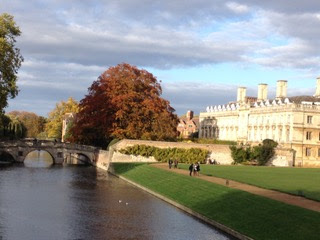Christina Koning was born in Borneo and lived in Venezuela and Jamaica before growing up in England. She now lives in Cambridge. She's been a journalist and reviewer for The Guardian and The Times, and a university lecturer at Oxford and Cambridge. She's written five literary fiction novels that have been very well received and were shortlisted for, and won, prestigious prizes. Her interest in historical fiction led her to her mystery series featuring Frederick Rowlands, a smart detective who was blinded in the first world war. Her latest novel, Murder at Bletchley Park, explores the work of the Enigma code breakers and was shortlisted for the eDunnit prize at this year's Crimefest. In today's post, she tells us more about the creation and development of her intriguing series.
The impressive range of international settings for the
articles featured on ‘Murder is Everywhere’ got me thinking about my own
interest in setting and landscape. Finding the right location for a novel has
always been important to me — as a glance at my backlist will confirm. From the
late 1977 Edinburgh setting of my first novel, A Mild Suicide, I moved
to Venezuela in 1953, with my Encore Award winning Undiscovered Country, set
among the expatriate community in the Maracaibo oilfields. My third novel, Fabulous
Time, moved between 1960s Sussex and China in the 1910s; The Dark Tower
was set in South Africa, during the Anglo-Zulu wars of the 1870s, and Variable
Stars, about the 18th century astronomer, Caroline Herschel, was set in
Hanover, Bath and London, from the 1780s onwards.
From this, it will be apparent that I not only like to mix it up a bit when it comes to setting, but also as regards the time in which a book is set. I’ve always enjoyed exploring the past — which seems to me a way of coming to understand the present — and so, when I started writing the first book in what is now the Blind Detective series, It seemed a logical progression from my earlier, historical novels. I had no idea that it would turn into a murder mystery — let alone a series. I’d simply decided to write a novel based around the life of my maternal grandfather, a veteran of the First World War, as a way of marking the centenary of the war’s outbreak.
It was only
as I got deeper into the story, whose central character, Frederick Rowlands, a
blinded war survivor, works as a switchboard operator for a firm of City
solicitors, that I recognised its potential as a whodunnit — and my hero’s role as a (somewhat reluctant) detective.
From then
on, the mingling of historical research with the tight plotting necessary to
keep the action moving along, has continued to engage me. The Blind Detective
novels are set at two-year intervals, beginning in 1927, and cover the interwar
years and the Second World War (I have reached 1943 at the time of writing). As
with my earlier books, the locations vary —
from London in the late twenties, to Berlin in the early thirties, Barcelona
during the Civil War, and Dublin on the eve of the Second World War.

Christina researching Murder at Hendon Aerodrome from a Tiger Moth
Throughout,
events taking place on the world stage are mirrored by those in which my
detective finds himself caught up. Thus, while the first book, The Blind Detective, dealt
with the aftermath of the Great War, the second, Murder in Regent’s Park,
ends just before the Wall Street Crash of 1929. The worldwide financial crisis
this precipitated forms the background to Murder at Hendon Aerodrome,
the third novel in the series, which is set in 1931 — although the book’s main
focus, as the title suggests, is the flying craze of the early 1930s. With Murder
in Berlin, set in that city in 1933, as Hitler comes to power, the personal
and the political become even more intertwined, as Rowlands goes to Berlin to
track down a missing child and is caught up in the tumultuous events of the
times.

Brandenburg Gate, Berlin
Running
parallel to the historical events described in the Blind Detective books, are
those concerning Rowlands’s family and friends — including his
wife, Edith, and their three daughters. These appear at different stages in
their lives, each playing a part in the action, to varying degrees. This was
both a way both of indicating the passage of time, but also of showing how
individual lives are part of history.
Even though researching the social and political background is enthralling, I try to keep in mind that these are principally detective stories, focusing on murder and other nefarious crimes. Again, the historical background isn’t just set-dressing, but has a bearing on the plot — with, for instance, the prevailing violence of Nazi-era Berlin echoed in the murderous events Rowlands finds himself investigating in that story.

Street scene, Barcelona
Similarly,
Murder in Barcelona links two seemingly unconnected plot strands — the
murder of an actress, during a film shoot in Cornwall, and the turbulent events
of civil war-torn Barcelona — revealing themes of betrayal common to both.
Murder in Dublin, set in neutral Ireland as war breaks out in Europe, sets
a tale of internecine warfare within an aristocratic family against the wider
conflict.

The Temple Bar, Dublin
Even when
the story focuses on events nearer to home, as in Murder
in Cambridge, in which Rowlands become involved in
the suspicious death of a female student at a Cambridge college, it becomes
clear that the mystery must be seen in a wider context — with the struggle for
women’s education very much to the fore. In my most recently published book, Murder
at Bletchley Park, this theme is developed further, with Rowlands’ eldest
daughter, Margaret, a Cambridge mathematician, seconded to ‘Station 43’ (as
Bletchley Park was known), to work as a cryptographer, and finding herself
suspected of betraying secret intelligence to the enemy.

Cambridge

Bletchley Park, still as it was in the forties fighting the war
Writing the
Blind Detective series has given me a wonderful opportunity to explore this
particular period of the past, and to consider themes such as the rise of
fascism in Europe, women’s rights, and the way that individual
lives are affected by war, while constructing what I hope are intriguing
mysteries. That the events which took place around a century ago still resonate
throughout the present day makes them, to my mind, entirely relevant. And — serious
themes aside — it has given me the chance to immerse myself in the glamour and
elegance of the 1930s, as well as the more austere, but no less fascinating,
wartime years. If nothing else, the books pay homage to that Golden Age of
crime writing which exactly corresponds to the period in which my books are
set, and without which they would never have been written.

















A fascinating aspect of the series is how the blind detective uses different senses to get clues. No doubt a lot of research was involved in that.
ReplyDeleteThat was indeed a fascinating part of researching these books. I was lucky to have access to the library at St Dunstan's (the institute for the war blinded) which had many first-hand accounts of how newly blinded war veterans coped with finding their way through the world.
ReplyDelete